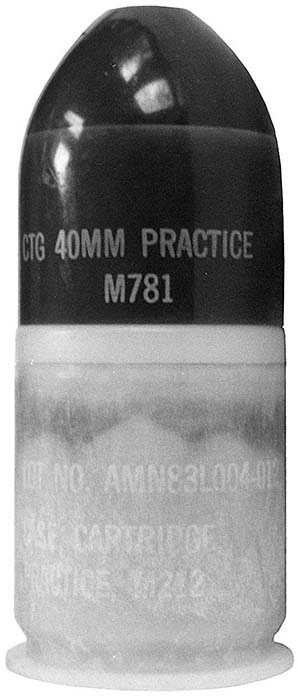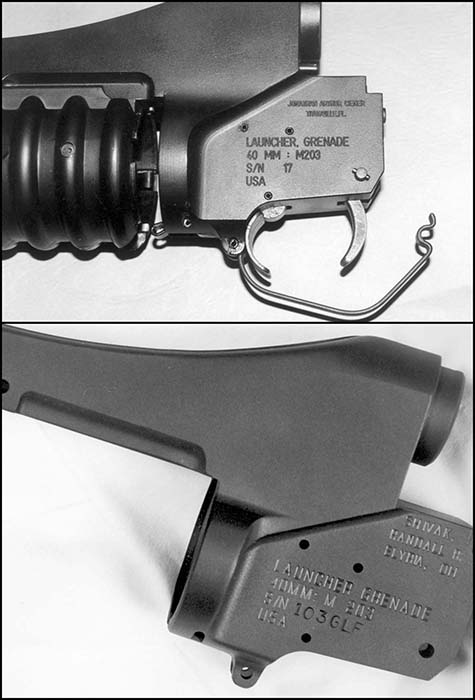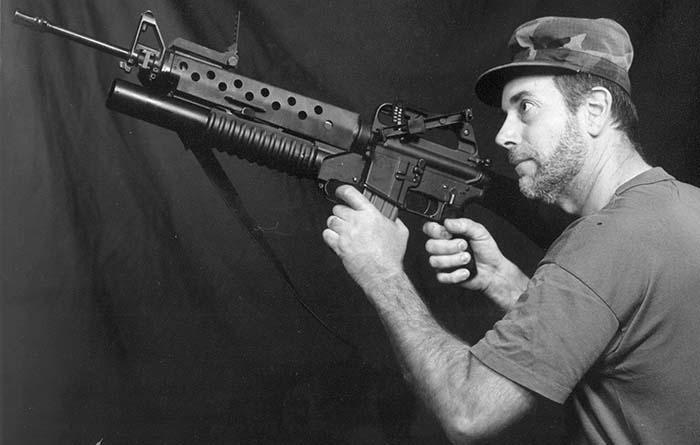Randy Shivak is one of the premiere manufacturers of civilian owned M203s and has been manufacturing them since 1994. Credit J. David Truby
by J. David Truby
You’ve seen them on all of the Vietnam War movies and TV shows, on the combat/terrorism/SWAT/peace-keeping news footage on CNN, non-firing replicas are sold to collectors. But, look closely and you might just see a few turn up on your local gun club firing range as collectors discover the M203 40mm grenade launcher.
Originally designed to mate with the M16 for tactical military and police use, the initial M203s were built in limited numbers for the civilian collector and esoteric sport shooter market by Jonathan Arthur Ciener, and, more lately by Randall Shivak.
“BATF classifies the M203 as a destructive device and they are completely legal to own under the classification. With signal and other recreational loads they are totally safe and nondestructive,” Randy Shivak says.
Ciener, an innovative Florida ordnance engineer who is no longer in the M203 business, adds, “That good old M203 is just the thing for the imaginative gun buff who wants to go to the next level of collector’s stratosphere. It’s the adult boy’s ultimate expensive and totally fun toy!”
The standard M203 unit is a breech loading, pump action, single-shot 40mm projectile launcher that is mounted under the barrel of a rifle. It’s 15.52 inches long, and adds just a little over 3 pounds to its host AR15 or M16, 3.6 pounds when you include the standard 40mm round. Maximum range is 500 meters, although its most effective results are within 300 to 350 meters.
One of my fellow advisers to some Central American military units in the 1980s said of the M203, “It’s like having your own brass knuckles in a barroom brawl.”

The 781 40mm practice round is easily reloadable for long term continued use. A variety of signal and pyrotechnic loads are available to the civilian shooter. Credit: J. David Truby
Five standard types of ammunition are produced for the M203: The M406 HE (High Explosive) round, M433 HE armor-piercing, M576 buckshot antipersonnel round, and the M407 and M781, which are practice rounds. In addition there are also tear gas and various signal loadings readily available to military and law enforcement users. According to Randy Shivak, there is no operational 40mm ordnance available to the civilian market, both for legal and liability reasons.
The velocity using the M406 HE cartridge is 245 fps. This is the most common military round used, an antipersonnel load with a lethal radius of 5 meters. The M433 round will penetrate 2 inches of steel armor plate before showering its lethal fragments.
Attaching the M203 to your own M16 is not quite the happy task that the Colt sales literature promotes, although it is hardly a major challenge to the average user. It’s basically a matter of a couple of mounting screws and the military manuals are very easy to follow in this regard.
You load the M203 by depressing the barrel release and pushing the barrel forward. This opens the breech and automatically cocks the unit. However, an automatic safety sear also activates at this point to prevent an accidental discharge. Insert the round carefully. Aim, fire, observe and repeat.
The M203 entered US Army service in 1970, to replace the M79, the fabled Blooper that looked essentially like a short, fat, single barreled shotgun that fired 40mm grenades.

The major problem with the M79 was that the user generally didn’t also carry a rifle and certainly couldn’t use both weapons at the same time if he did. By replacing the old Blooper with the M203, the grenadier once more became a rifleman. Although R&D and initial contract cost numbers are unavailable, a 1978 commercial production contract let to Colt by the DoD listed each M203 at $231.88. In addition to American use, the early units were also issued to South Vietnamese troops, plus hundreds were sold to Australia, New Zealand and to the United Kingdom during the Vietnam years. Later, the Pentagon sold and gave thousands of M203s to our allies as military and law enforcement assistance.
The M203 was developed by AAI Corporation at the direction of the US Army Weapons Command to replace to the M79, which had its beginnings in the early 1950s at Aberdeen and Springfield.
The original design, though, had come from Colt in 1964 with the development of their CGL-4, which the Army called the XM148. Nearly 1,800 XM148 units were field tested in Vietnam in 1967. Although well liked by some troops, the units officially “failed” the field-testing and were withdrawn.
Ironically, in 1972, while representing Interarms in Vietnam, the late Dr. Edward Ezell said that he saw a battered XM148 recovered from a VC unit that “was probably happy to have this wonderful firepower that the Americans didn’t want.”
Despite that history, R&D began on a replacement in the Fall of 1967 and AAI won the competition with its M203 design. By April of 1969, 500 XM203 units were sent to Vietnam for field-testing. One of the many, many glowing testimonials to the XM203 was the number of units that attempted to replace their M79s with the new test weapon. The XM203 won enthusiastic endorsement.

Because AAI was a small company and the military needed massive amounts of M203 units, manufacture was undertaken by Colt in 1971 on a license purchasing agreement. Obviously, by that time supplies of everything to those American forces that were still in country were slowing down, although the new launcher did make it into combat. Most accounts estimate that Colt has produced between 500,000 and 800,000 units for US and friendly foreign governments.
At the 1992 meeting of the American Defense Preparedness Association (ADPA) meeting, Colt showed its M203H, which is essentially a standard M203 with a fixed pistol grip and butt stock. It also uses a 250-meter ladder sight. The M203H is stand-alone weapon.
According to Ciener, back in the mid 1990s, there was new interest in the M203 from some US-friendly middle eastern nations that want to add this relatively inexpensive and useful bit of ordnance to their national defense and law enforcement systems.
“I was approached by some folks in our government to build several hundred M203s for one our allied nations in that region,” Ciener says. “But, that really did not work out.”
As serious users will attest, Ciener’s version of the old bloop tube is rugged. Each unit’s receiver is constructed of high strength, forged aluminum. Although it is almost always attached to an M16, it can be operated independently.
Randy Shivak moved into the M203 community in 1994. The year before he was a roofing contractor with a great business as well as a self-taught machinist who found he enjoyed that better than his day job.
“I got bitten by the Class III bug in 1993, loved machining, had an M16, and wanted to go for more, “ he says.
He studied federal and state law, talked with some friends, bought some more machining equipment, then got his manufacturer’s Type 10 license and began to produce M203s and M79s.
What had been a hobby quickly grew to a business. He was using GI parts and building his own receivers. As demand quickly grew, he added more machining equipment, and realized this new business was outdistancing his day job.
“In 1998, I went out of the roofing business and began devoting my full time to my fully functional 40mm weapons and accessories. I now have a very active website, too, and have expanded offerings again, selling real M79s, real M203s, parts, all sorts of practice rounds, repair facilities and I am doing some contract work as well.”
Randy said there is a very loosely organized “users club” of 40mm collectors and hobbyists who are trying to get a 40mm competition included at Knob Creek. His customers come from all walks, trades and professions, including one federal officer who lives in a very gun-unfriendly state.
. Rather than give you today’s BATF drill for legally owning an M203, which may change tomorrow, my advice is to personally contact Randy Shivak or Dan Shea, the two experts in this matter, as noted at the end of this article.
In the meantime, enjoy the civilian side, where the emphasis is clearly on sport, fun and recreation. The late USMC Gunnery Sergeant Donald Steffey, who knew the M203 well from firsthand Vietnam experience, championed the sport value of the civilian collector’s use, saying, “These bozos that say that military equipment has no sporting or recreational use are simply ignorant of the truth, or lying.
“Private collectors who own M203s use them safely, carefully and totally within the law, simply as outdoor recreation, to send an inert (non-explosive) or flare round harmlessly up in the air.
“There is a literal analogy with firecrackers, rockets and the 4th of July…recreational use of explosives. I guess it’s tough for some of the anti-gun paranoiacs to see that when they have their heads wedged so far up where they do,” Don added.
Dr Tom McCoy is a civilian who owns one of Jonathan Ciener’s classic M203s, and has been enjoying this hobby for some years now.
Tom brings his M203-laden M16A1 up to the firing line amid the time-honored cry of “Let the games begin.” Thus, on a nearby field and quarry area, Dr. McCoy and friends enjoy afternoons of blooper-style competitive sport and entertaining pyrotechnics.
Military and civilian prices for the old and remade M203s ran about $700 for the entire unit. By 1998, prices for civilian-manufacture M203 receivers were about $950. Today, receivers for the M203 cost nearly $2,000, while those for the M79 run around $1,700. Within the past year I have seen ads for a used Ciener unit for $3,000, two of Shivak’s units at $3,200 and $2,900, respectively, and an original Colt M203 in mint condition for $4,300. Of course, there are still bargains to be found out there.
Sources of Equipment, Parts, Accessories
Mr 40mm
Randall R Shivak
Elyria, Ohio
(440) 284-1044
www.mr40mm.com
Long Mountain Outfitters
Dan Shea
631 N. Stephanie St. #560
Henderson, NV 89014
(702) 564-0948
www.longmountain.com
| This article first appeared in Small Arms Review V7N4 (January 2004) |











